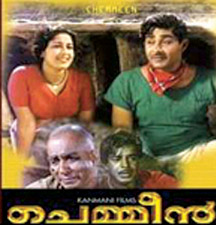Memorable Indian films: Chemeen
K S Sivakumaran
This film was shown in Colombo in 1969. It was a Malayalam-speaking
South Indian film. Ramu Kariat was its director. The film was adapted
from a popular novel in that language by a celebrated writer by name
Thakali Sivasangaram Pillai.
 Malyalam is akin to Tamil. I being a Tamilian did not find it
difficult to understand the dialogue which was also minimal as it is in
good cinema. Malyalam is akin to Tamil. I being a Tamilian did not find it
difficult to understand the dialogue which was also minimal as it is in
good cinema.
The visuals were cinematic so a refined cinegoer could understand and
enjoy the story of the film.
Chemeen was a different kind of film then when compared with rest of
the Indian films of the 1960s. But I had a few reservations in my
assessment of the film. It was not a very serious film as a serious film
as one by the great Satyajit Ray. Therefore it was not totally
satisfying. By this I mean that the enjoyable parts were not evenly
placed.
What was missing in the film was that there was no explicit ‘message’
in the film as one would have expected in a work of art.
At least what most people expected a clear message then. But these
days it is implicit and also leaves it to the reader or viewer to
interpret.
However I felt that the director had not succeeded in communicating
to me what was unique about the story.
Notwithstanding there were two reasons, I think, why ‘Chemeen’ was
pleasing to a discriminating cinegoer. One: the film was realistic in
the structure. Two: It gave us a kind of entertainment that is found in
a commercial film that depends on certain formula. I have read the novel
in both English and Thamil translations.
But the film was not as impressive as or as satisfying as the novel
was. But within its range, the film had tried to present the essence of
the novel, except for the ending which was a bit romanticized.
 ‘Chemeen’ was like a ‘Romeo-Juliet’ story the story of two
star-crossed lovers who could not consummate with marriage by force of
circumstances. It was a tragic story. But the story had a twist, adding
a new meaning into it. ‘Chemeen’ was like a ‘Romeo-Juliet’ story the story of two
star-crossed lovers who could not consummate with marriage by force of
circumstances. It was a tragic story. But the story had a twist, adding
a new meaning into it.
The twist was in the end where the heroine, a married woman,
surrenders herself to the embrace of her former lover. As lovers they
had not touched each other before. But now they did. The heroine does
this because her husband doubted her chastity even though she was
faithful to him. As a protest she did this at the end perhaps.
So at that time when the story was happening, it was a bold step of
the heroine to challenge the very bottom of the virtue of Indian
womanhood. This kind of thing was a new theme in the then South Indian
Cinema.
It was not the story nor did the bare events in the film that
impressed me, but the realistic way the background events were depicted
that make me sit and watch. To elaborate - the social background,
geographical landscape and seascape and the settings where the story
takes place were convincing. The beautiful sea coast of Kerala state in
India reminded me of Lanka’s sea-lanes and beaches.
These were stunningly photographed by Bartley in Eastman colour. The
sea and it surroundings, the lives of the fisher folk wee brought in a
series of sequences. The film was realistic in this sense – the players
were very natural except for occasional glamorization of their costumes
and makeup.
This was apparently to please the masses of that time they wanted the
stars to appear glamorous on the screen. The actors were playing their
respective parts very well, I must add.
Their acting was meaningful when they were captured against the
backdrop. The surroundings were most part in the open-outdoor shooting.
I liked the cinematography the best contribution in the film. The
camerawork was judiciously handled. Apart from this the magical score by
the reputed composer Salil Chaudry was fascinating. He used indigenous
folk tunes free from heavy western orchestration. Ramu Kariat’s
direction of the film was lyrical at times - the newly married couple at
the beginning masking their home. While Ray was an artiste and an artist
who told you a message in a poetic sort of way, Ramu Kariat was not so
subtle.
The latter was in a way a realist picturing the story as objectively
as he could. Essentially with the assistance of the cinematographer,
Bartley, Kariat achieved something noteworthy and praiseworthy of the
early Malayalam Cinema.
[email protected]
|



